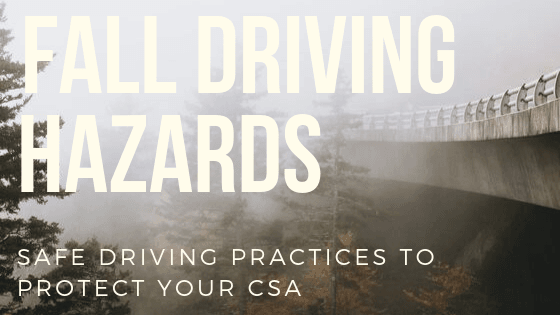Fall Driving Hazards for Truckers
Fall is quickly approaching, and with it comes leaf-peepers, fall allergies, and you guessed it – driving hazards.
Don’t get us wrong, we love Autumn as much as anyone else. But these driving hazards can make it a tricky time to navigate the roadways. We thought we’d round up our favorite tips for dealing with these everyday driving hazards to make your time on the road a little safer.
Leaves in the Roadway – They may be beautiful but don’t hard break on a leaf-covered roadway. Not only do they hide potholes and other road hazards, but wet leaves can be as slippery as ice! Best to reduce your speed and leave plenty of room between you and the four-wheelers around you.
Leaf Peepers – Where there are leaves, there are bound to be Leaf Peepers. Look out for drivers who seem to be crawling along the highway or making unpredictable stops. If you’re driving behind a car with out of state plates, we recommend giving them a little extra space, just in case.
Back to School – This is a hectic time for families, and it means more kids, cars, and busses on the road. Watch out for an increase in pedestrian traffic in the morning and afternoon as children walk to and from their neighborhood bus stops.
Fog – Cold fall mornings often call for fog, which can drastically decrease your visibility. Fog generally settles in low places or areas surrounded by hills, water, mountains and trees. When driving in foggy conditions, slow down and do NOT use your high beams, those bounce off the fog and create a glare. Low beams only for fog!
Frost – During this transitional season, we usually get our first taste of frost, as temperatures can drop wildly in the evenings. Frost accumulation is most common on bridges, overpasses, and shady areas.
Sun Glare – Surrounding the Fall Equinox, the first 15-45 minutes after sunrise and before sunset are heavy impact times for sun glare. We recommend a good pair of sunglasses for the daytime, keeping your windshield clean, using north/south roadways when possible, and streets with tree cover when it’s not.
Deer – You are statistically 3.5 times more likely to hit a deer in November than at any other time of year. Their mating habits make them more likely to cover more ground, increasing the likelihood of an encounter. We don’t recommend swerving to avoid an animal on the road, if you have enough time you might flash your brights or hit the air-horn.
Don’t forget that driving citations don’t have a season. Have a ticket? Join ORDP for the best coverage in the industry.
Safe driving!


Recent Comments